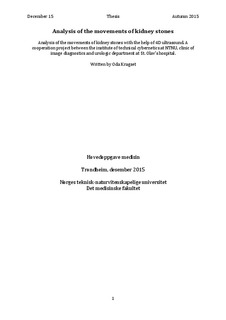| dc.description.abstract | Objective: The main purpose of this pilot study was to gather information on the movements of kidney stones in a 4 dimensional (4D) perspective through a respiratory cycle, making time the first dimension and space the three remaining dimensions. This information was gathered with 3D ultrasound. To date researchers have published studies utilizing 2D ultrasound to track kidney stones. Still, to this date there are very few research papers where 3D ultrasound has been used for the same purpose. Additional objectives of this study were to explore the possibilities for digitalizing the data from the 3D ultrasound followed by analysis of the data in navigation software currently available at our institution. Individual patient variables were recorded. The final objective was a detailed analysis of 4D kidney stone trajectory. All data gathered in the study will be passed on to the doctoral project “Robot-Assisted tracking of kidney Stones using Medical UltraSound (RASMUS)”, that plans to develop a robot arm capable of accurate tracking of kidney stones with 3D ultrasound, which ultimately may lead to more effective ESWL-treatment. Materials and methods: The kidney stones of 20 patients were examined with 3D ultrasound in connection with planned extracorporal shockwave lithotripsy (ESWL) treatment at St. Olav’s hospital day surgery unit between August and October 2015. Written consent was obtained from all 20 patients, and the study was approved by REK. Ultrasound data of 20 patients were obtained, 5 patients were excluded due to no kidney stones found at the ultrasound examination. In November 2015 supplemental clinical information was gathered from the 15 remaining patient journals. Due to analytical difficulties only 5 of the ultrasound recordings were available for the final analysis. All recordings were analysed in cooperation with Sébastien Muller at SINTEF. Results: The 3D ultrasound data was successfully digitalized and stone trajectory was reconstructed in navigation software. Results were presented in 2D graphs showing the stones’ displacement in three perpendicular directions, and 3D graphs showing a reconstruction of the kidney stones’ trajectory from the analysis results. In all patients the 3D analysis revealed that stone movement was confined primarily to one plane. Range of movement was approximately 5-15 millimetres. Analysis of stone movement during respiratory cycles revealed that the time period of least movement was at the completion of exhalation. Comparing the graphs to the respiratory curves, the stones barely moved at the end of compared to the start of the respiratory cycles. The stones seem to follow a regular rather than a random path of motion. Both reviewing the ultrasound recordings and studying the similarities between 2D graphs suggest certain patterns of movement. Pearson’s and Spearman’s method also show statistically significant correlation between the kidney stone’s movement during 1. and 2. respiratory cycles in most patients. Cross-correlation analysis could not be performed in 10 patients because the ultrasound recordings had a too narrow sector was used. Recordings containing more respiratory cycles would have been beneficial in establishing better reproducibility. Conclusion: The results address several aspects of ESWL-treatment. The movement analysis reveals that stones have little or no movement at the end of exhalation, suggesting that the optimal time to activate the ESWL energy would be at the end of exhalation. Results also suggest that 2D ultrasound will often be sufficient for tracking of kidney stones; however, 3D ultrasound should be considered as some stones might have 3D movements. This pilot project has revealed several details in the settings used for the actual probe that will better enable the navigation software to accurately follow stone movement. Real-time 3D ultrasound stone tracking combined with navigation analysis on stone-trajectories might potentially lead to greater treatment efficiency in ESWLtreatment | nb_NO |
